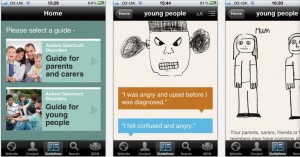The Apple iPod Touch as a vocational support aid for adults with autism: Three case studies [PDF]
“Abstract. Personal digital assistants (PDAs) offer task management and organisational features that may be utilised to help people with autism spectrum disorder (ASD) function more successfully in the workplace. Additionally, onboard video cameras and addon software applications provide rich opportunities for the implementation of personalised vocational supports for individual workers. This article reports on three cases of workers with ASD who have been trained to use Apple iPod Touch PDAs as vocational supports in the workplace, resulting in improved functional performance and reduced behavioural challenges.
Keywords: Autism, assistive technology, cognition, occupational therapy, personal digital assistant, vocational rehabilitation”
From the Journal of Vocational Rehabilitation 37 (2012) 75–85
Regarding Apple iPod Touch devices:
“…These devices can be carried in a pocket, on a belt clip or on a necklace lanyard, making them appropriate for workers who must use their hands on the job…”
They used the devices to provide the following support
- task reminders
- task lists
- video-based task-sequencing prompts
- behavioral self-management adaptations
- way-finding tools, and other supports
One example from the study was a successful pilot with Jeffrey who was having difficulties in his job in a fast food environment. The iPod was worn in a protective case on a belt clip. An occupational therapist worked with Jeffrey to set reminder alarms for tasks, different tasks were given different sounds with additional audio recordings of task notes that could be listened to for extra reinforcement. They didn’t need to use any additional apps, they just used the built-in apps like “Clock”.
You can find details of how to use the built-in apps by going to Apple’s website and downloading the appropriate iPod manual (these are usually PDF files)
e.g. iPod touch user guide for iOS 6.1 Software (June 2013) [PDF]
Another trial was Lily, a 20-year old woman with Downs Syndrome and ASD. She was employed in a housekeeping duties role.
“…The Storykit application was downloaded from the Apple iTunes Store in order to build verbal and picture-prompting task lists, replacing Lily’s laminated paper prompts…Storykit allows a user to easily create talking picture books…
…The device led to improved work performance, fewer behavioural challenges, and a marked decrease in telephone calls for help to her job coach or mother during the workday.”
In the report they do acknowledge
…It is important to note that each of the three workers had functional cognition, vision, hearing and manual dexterity sufficient to interact with the iPod Touch without the need of accessibility adaptations. Many people with ASD have cognitive, sensory or motor conditions that would make utilisation of such a device problematic…
Once again this highlights how tailored use of any device needs to be to the particular impairments of the individual.
Interesting emerging new role for Occupational Therapists in supporting setting up electronic devices and installing and using appropriate apps. Particularly encouraging is that in each of the three case studies the use of the iPod device helped people complete work tasks with more autonomy and with less supervision in the workplace – one of the factors affecting employment. Some professionals are nervous about technology because they think it will be used to replace their existing jobs, what you can see from a study like this is just how important and valuable their existing skills are if they adapt to utilise new technologies as tools to enhance their roles and make better outcomes for their clients and reduce the stress on clients’ carers.
“…This is an exciting time for anyone in the fields of education, physical rehabilitation and vocational support, where we are seeing a long-awaited merging of consumer products and assistive technologies for all…”
More details about some of the extra apps used:
App: Storykit
So here’s an example of techniques based on a paper-based system being successfully transferred to a hand-held electronic device. Storykit is an iPhone/iPod app, a project of the International Children’s Digital Library (ICDL) created by the University of Maryland’s Human-Computer Interaction Lab.
App: VoCal
VoCal Voice Reminders By GZero Ltd. “…VoCal fuses a Dictaphone, Calendar and Alarm system into one…”



